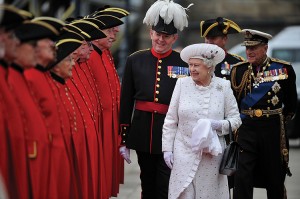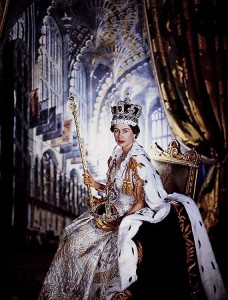Queen Elizabeth Is Laid to Rest
Monday, September 19th, 2022
In June 2012, Prince Philip and Queen Elizabeth II celebrated her Diamond Jubilee (60th anniversary as queen) at Chelsea Pier in London.
Credit: © Bethany Clarke, Getty Images
People around the world are mourning the loss of Elizabeth II, the queen of the United Kingdom of Great Britain and Northern Ireland. She became queen when her father, King George VI, died in 1952. Her reign was the longest in British history. She passed away at the age of 96 on Thursday, September 8, after ruling for seventy years. She spent her last weeks at Balmoral Castle in Grampian Region, Scotland, and died surrounded by family members. Thousands of people from all over the world lined the streets of London to pay respects at the Queen’s funeral today, September 19. The state funeral was held at Westminster Abbey. The Queen was married and crowned at Westminster Abbey. The ceremony was followed by a procession through London to a chapel in Windsor Castle, the Queen’s final resting place near her husband Prince Philip.
As a constitutional monarch, Queen Elizabeth was formally head of state in the United Kingdom. But she had no power over what the British government does. Laws are formally enacted in the name of the queen, but their content is the responsibility of the government.
Elizabeth Alexandra Mary was born in London on April 21, 1926. Her father was the Duke of York, second son of King George V. Her mother—Queen Elizabeth, the Queen Mother—was the former Lady Elizabeth Bowes-Lyon, the daughter of a Scottish earl.
Elizabeth’s father became king in 1936 after his older brother, King Edward VIII, gave up the throne to marry a divorced American woman. This event greatly changed the course of 10-year-old Elizabeth’s life. It made her the heir to the throne, since George VI had no sons and she was the older of his two daughters.
Princess Elizabeth spent most of her childhood at Windsor Castle, in Windsor, near London. The castle is the British royal family’s main residence outside of London. Buckingham Palace, in London, is the family’s main residence. Princess Elizabeth and her sister, Princess Margaret (1930-2002), were educated at home by governesses. In March 1945, during World War II, Elizabeth joined the Auxiliary Territorial Service, a support branch of the military. She joined to train as a mechanic to repair military vehicles for the war effort. But Elizabeth served only until May, when the war in Europe ended.
Princess Elizabeth married Philip Mountbatten, a British naval lieutenant and member of the Greek royal family, on Nov. 20, 1947. Her husband became Prince Philip, Duke of Edinburgh (1921-2021). When King George’s health began to fail, Princess Elizabeth and her husband began to undertake more public duties. The king died on Feb. 6, 1952, and Princess Elizabeth succeeded him as the British monarch that day. The coronation of Queen Elizabeth II took place on June 2, 1953, in Westminster Abbey, London.

Queen Elizabeth II poses during her coronation at London’s Westminster Abbey in 1953.
Credit: © Cecil Beaton, Camera Press/Redux Pictures
After a general election, the queen formally appoints the prime minister. In practice, this person is the leader of the majority party in the democratically elected House of Commons. The queen has a weekly meeting with the prime minister to discuss public affairs. The prime minister is not obligated to act on her advice, but may find it useful because of her many years of experience. The Queen welcomed 15 prime ministers in her career, including Prime Minister Liz Truss who assumed the role this Tuesday.
The queen’s chief public role was to attend ceremonial state occasions and to represent the United Kingdom in visits throughout the country and the world. Queen Elizabeth traveled extensively. In the United Kingdom, the queen sometimes puts ceremony aside and meets informally with subjects. She hosts luncheons at Buckingham Palace, which are attended by people of many different walks of life.
The queen is also head of the Commonwealth of Nations, an association of independent countries and other political units that have lived under British law and government. Queen Elizabeth has no authority in Commonwealth nations. She serves mainly as a symbol of historical ties.
The queen and Prince Philip had four children. The children are Charles, Prince of Wales (1948-…); Anne, Princess Royal (1950-…); Andrew, Duke of York (1960-…); and Prince Edward (1964-…). Prince Charles became king after Queen Elizabeth passed away. The older of his sons, Prince William (1982-…), is next in line after his father as the heir. The royal family’s surname is Windsor. However, in 1960, Queen Elizabeth announced that her descendants, except for princes and princesses, will bear the surname Mountbatten-Windsor.
The royal family has two country residences. One is Balmoral Castle in Grampian Region, Scotland. The other is Sandringham, an estate in Norfolk County, England. Queen Elizabeth enjoyed country life and bred dogs and horses. She owned successful race horses.


